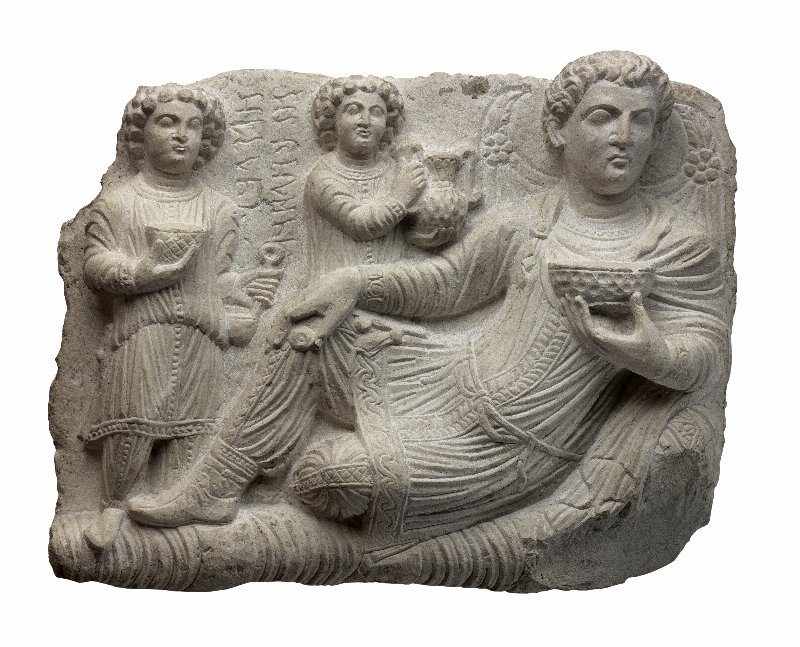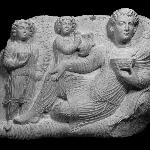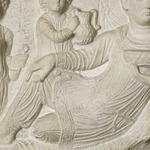Statue
Relief
B8902
Location: On Display in the Rome Gallery
From: Syria | Palmyra
Curatorial Section: Near Eastern
| Object Number | B8902 |
| Current Location | Rome Gallery - On Display |
| Culture | Roman |
| Provenience | Syria | Palmyra |
| Section | Near Eastern |
| Materials | Limestone |
| Technique | High Relief |
| Iconography | Man | Vase | Youths | Amphora | Cup | Inscription | Banquet Scene |
| Description | CBS Register: Fragment of a slab in limestone; mortiary stone. In high relief young man reclining with coarse in his left hand, 2 youths standing, the one holding an amphora, the other cup, 2 lines of Palymere inscription. Romano: "Inscribed rectangular loculus relief with banquet scene composed of three figures: two boys and a reclining male. To the viewer's right is a beardless male figure reclining on pillows supported by his left elbow, with his body and head turned to the front. He holds a cup with a honeycomb pattern in his left hand, bent across his body, while his right hand rests on his right knee and holds a round object, a fruit or flower. His legs are crossed with the right bent and the left turned underneath, disappearing into the background. He wears a richly decorated (possibly with embroidery) Parthian-style belted, long-sleeved tunic with a central vertical band (with pattern of double palm fronds), neckline, cuffs (medallions), and lower edge (wave pattern) decorated in low relief. A chlamys is fastened over the right shoulder with a circular pin, wrapped around left shoulder and over left arm. He wears loose trousers with many folds, cuffed above the ankle and with a decorated vertical panel, and square-toed boots with a central flap. His hair is brushed forward with locks on forehead; triangular face; large oval eyes with traces of dark pigment on the irises; broad nose; and small mouth. Behind this figure is a dorsalium, a veil suspended from two rosettes from which palm leaves rise. In the center of the relief, behind the body of the reclining male is a small male figure holding to his left side an amphora with high-swung handles and body decorated in relief (honeycomb body, neck ornament, and tongues on neck). He is dressed in a long-sleeved tunic with a central vertical panel. His hair is rendered as a halo of globular curls. ANother small male figure appears to the far left in the relief, wearing a long-sleeved patterned tunic with a deep kolpos, trousers, and pointed-toed boots. He holds a cup to the front of his body in his right hand, and a ladle with a looped handle in his bent left hand; he wears a sword at his right side. His hair is treated in the same way as the other servant. The ground line for the scene is a rolled mattress or pillow with vertical striations. Between the two small figures are two vertical lines of an inscription in Palmyrene dialect of Aramaic. "Malku, son of Moquimu. Alas!" The back is roughly finished." Fowlkes-Child & Seymour: "Catalogue 109 depicts Malku reclining on a mattress and holding a bowl in his left hand a fruit in his right. His long-sleeved, belted tunic is embellished with a pattern of double palm fronds on its central vertical band and additional patterns at the cuffs and lower edge. A chlamys (cloak) is pinned at his right shoulder, a dagger hangs from his belt, and his boots are square toed with a central flap. A dorsalium (curtain) is pinned with rosettes to palm fronds behind him. Two young male attendants stand behind Malku, one holding an amphora, and the other a ladle and a cup. Their matching tunics have simpler embroidery than Malku's. Trousers, pointed boots, and a dagger hanging from the waist are visible on the figure on the left. The attendants have curls typical of the "Parthian" hairstyles." |
| Height | 46 cm |
| Width | 58 cm |
| Depth | 13 cm |
| Credit Line | Babylonian Expedition to Nippur II, 1890 |
| Other Number | CBS8902 - Other Number | P263719 - CDLI Number |
Report problems and issues to digitalmedia@pennmuseum.org.




